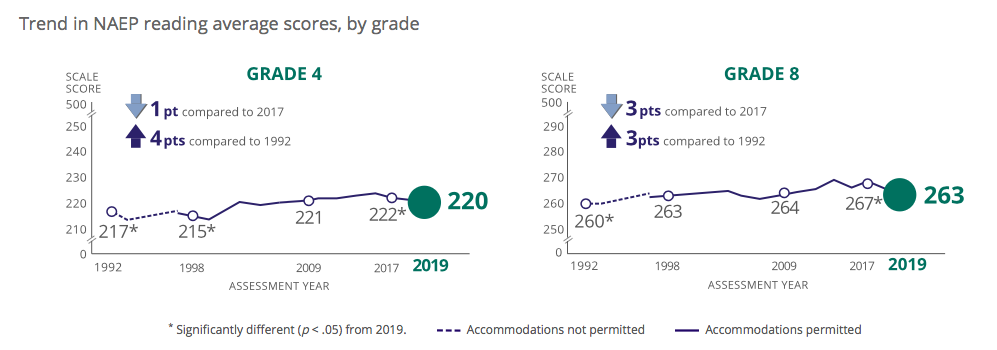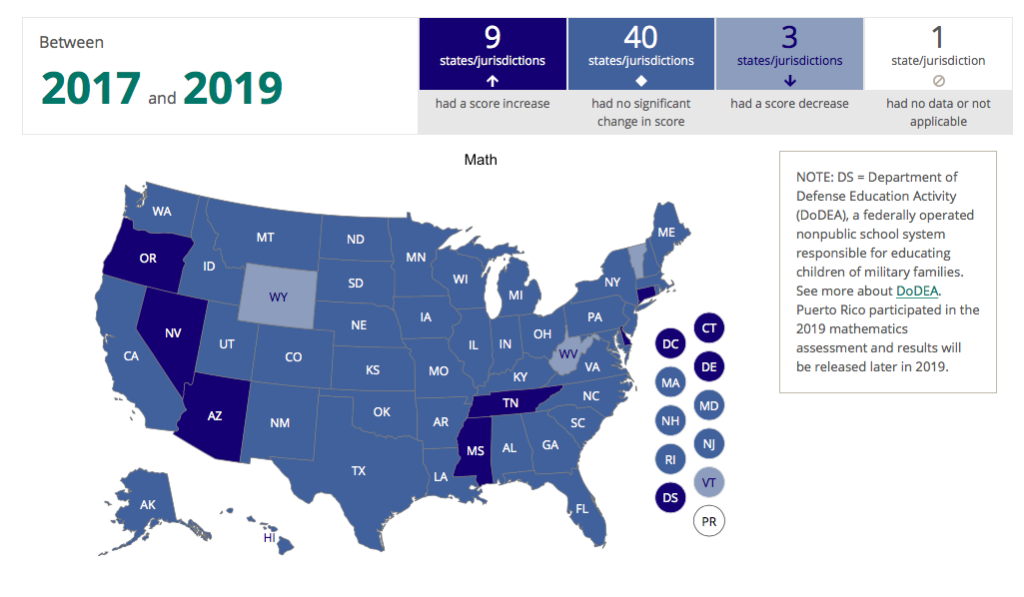
Wisconsin’s achievement gap between black and white students is the second largest in the country, only after the District of Columbia
Math scores nationwide in the majority of states showed no significant difference in the past two years, while nine states showed scores increases and three showed scores decreases.
November 4, 2019
By Ola Lisowski
Achievement gaps for Wisconsin students are second largest in the country, only after D.C.
American students are stagnating in math and reading achievement, according to a new national data release from the Department of Education. Wisconsin students demonstrated achievement that was not significantly different from their performance in 2017, or the nationwide averages as a whole. However, Wisconsin’s achievement gap between black and white students widened and now Wisconsin’s achievement gap is the largest of any state in the country, trailing only the Washington D.C. area.
The results come from a statistically representative group of students across the country who took the National Assessment for Educational Progress (NAEP) exam in the spring of 2019. More than 3,300 Wisconsin students in 4th and 8th grades took the exam. Approximately 296,600 students took the math assessment nationwide, while 294,000 students took the reading assessment.
In Wisconsin, 45 percent of students were at or above proficient in math, not significantly different than 2017’s proficiency rate of 43 percent. In reading, 36 percent of students were proficient, not significantly different than 2017’s rate of 35 percent.
Eighth graders showed similar stagnation across the two subjects. Just 41 percent of 8th grade students were proficient in math, compared to 39 percent in 2017. In reading, 39 percent of 8th grade students were proficient or better, the same percentage as in 2017.
Wisconsin students were either slightly above or not significantly different from the national average in each subject.
Nationwide, math scores increased by one point for 4th grade students and decreased by one point for 8th grade students.
Perhaps most shockingly, 2019 math scores are almost the same as those from 2009, showing a “lost decade” in student achievement. In 1990 to 2009, students showed significant gains in both subjects.
Nationwide math scores are nearly the same in 2019 compared to 2009, showing a “lost decade” in student achievement. In reading, average 2019 scores are just a few points higher than 1992 scores.
Reading scores were more dismal across the country. Scores in both grades fell from 2017 to 2019 nationwide, bringing 2019 scores just a few points higher, on average, then the 1992 scores. The vast majority of states did not show significant change in average scores, while 17 states showed score decreases.
The results come after years of funding increases to K-12 education. Still, while the overall picture showed a lack of movement for average scores, results at both margins told a different story: the achievement gap between high- and low-performing students is widening.
 A NAEP blog analyzing the results wrote that “the stagnation in average scores since 2009 marks a divergence in progress at the highest and lowest ends of achievement,” showing that focusing on average scores may hide the true story.
A NAEP blog analyzing the results wrote that “the stagnation in average scores since 2009 marks a divergence in progress at the highest and lowest ends of achievement,” showing that focusing on average scores may hide the true story.
Between 2009 and 2019, scores show a “divergence in between the lowest and highest achieving in both subjects and grades. The score at the 10th percentile dropped between 2009 and 2019 in both subjects at both grade levels. On the other hand, the score at the 90th percentile rose in both subjects and grades.”
A similar trend is apparent among racial and ethnic groups. In Wisconsin, the white-black achievement gap was 37 points for 4th grade math, the second-highest in the country, only after D.C’s 47-point gap. In 2017, the gap was 36 points. Reading scores for 4th grade showed a similar gap of 39 points between white and black students, an increase from 2017’s 33-point gap. The same was true for 8th grade students, showing achievement gaps do not close as students continue in their educations.
In a statement following the release, State Superintendent Carolyn Stanford Taylor acknowledged that “our persistent achievement gaps are a crisis. Closing these gaps is not only the right thing to do, it is imperative for our state.”
The state’s Department of Public Instruction is expected to release school and district report cards later this month.





